|
AGRICULTURE
SRI : A women farmer with a challenging move
Progressive farmer: first person to adopt the SRI technology in Sokuppam
Organic farmer : An early adoptor of SRI
Foremost responsibility: The importance of preserving native seed varieties
SRI : A women farmer with a challenging move |
|
Mrs. Vijayalakshmi, a middle-aged woman farmer owning a little over four acres at Vikravandi in Villupuram district, has suddenly become the celebrity of that area. The reason behind it is that the crop raised by her recently stood out from others. In the past few months, many farmers visited her field with an astonishing look and willing to know the “secret.” System Rice Intensification, or SRI, is her answer. Apart from the farmers, her field was frequently visited by scientist of TNAU, government officials and district collector.
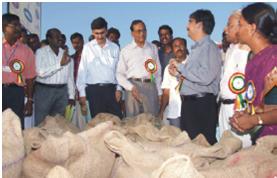
Mrs. Vijayalakshmi during the test harvest in fornt of Project Director, District Collector, Vice Chancellor and TNAU comittee members
Mrs. Vijayalakshmi was the first (woman) farmer who came forward and co-operated with the officials of TNAU to adopt SRI in four acres. Some farmers who were skeptical about SRI in the village called her mad for attempting SRI method. Raising mat nursery with a seed rate of 3 kg/ha was the initial attempt of the woman farmer. As an innovative idea instead of raising nursery in polythene sheet, banana leaves were used. Later 14 days young and single seedling was transplanted with a spacing of 22.5 X 22.5 cm. Alternate wetting and drying method of irrigation was practiced by the woman farmer. Weeds were controlled using cono weeder. As the days went, crop growth interms of profuse tillering has diverted the attention of the local farmers, who visited the field with astonishing look. Heavy tillering with a maximum of about 110 tillers was recorded. She has harvested a high yield of about 7.36t / ha under varahanadhi sub basin.
Contact details: Mrs. Vijayalakshmi, Vikravandi block, Villupuram district, Tamilnadu- 605 602.
Mobile: 9790238445.
Progressive farmer: first person to adopt the SRI technology in Sokuppam |
|
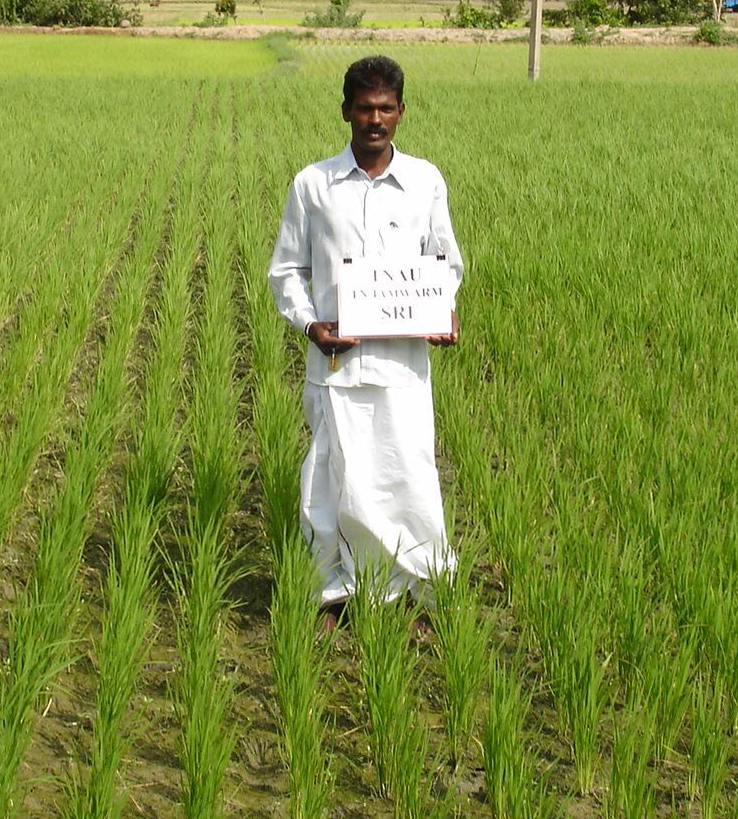
Mr.A.Vasu in his SRI field
Mr.Vasu Aranganathan, a progressive farmer from Sokuppam village of Gingee block in Villupuram district with a total land holding of seven acres was the first person in the village to adopt the SRI with the guidance of the outsourcing technical staff from oilseeds research station working under Tamil Nadu – Irrigated Agriculture Modernization and Water bodies Restoration and Management (TN-IAMWARM) project during 2007-08. He adopted SRI in 5 acres under canal irrigation. The experience was bitter during the cropping period due to the mocking of the villagers, but at harvest, the whole village was astonished to see the yield of rice. He has harvested a good crop with the yield of 78 bags under SRI as against 37 under normal method (per bag 75 kgs). Now he stands as a role model not only for his own village but also for the neighboring villages.
Contact details: Mr.A.Vasu, Mariyamman Koil street, So kuppam, Gingee Block, Villupuram District. Mobile:9943652120.
Organic farmer : An early adoptor of SRI |
|
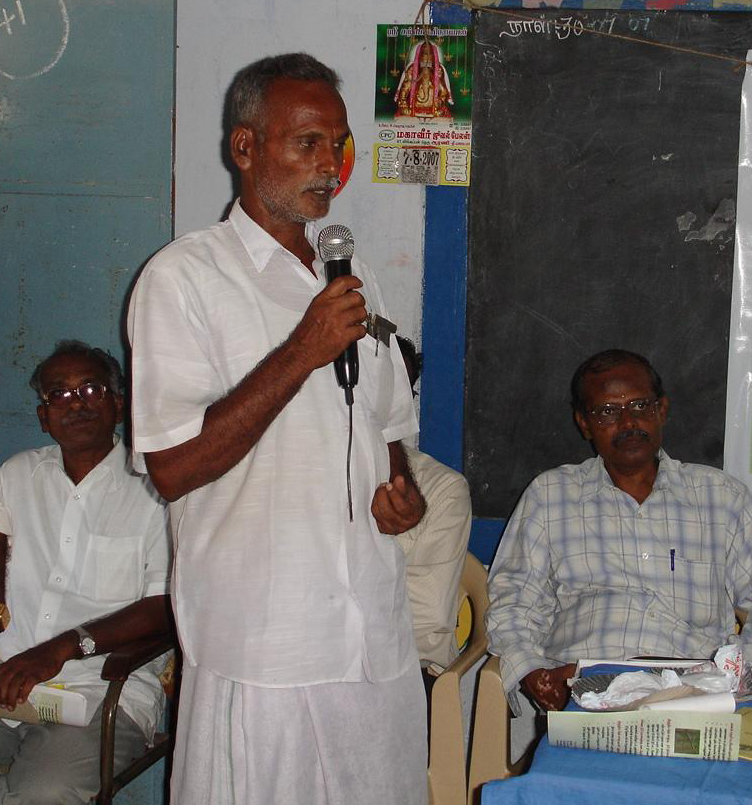
Pachaiappan from reddipalayam village
Mr. Pachaiappan, an organic farmer from Reddipalayam village of Gingee block in Villupuram district has adopted SRI in an area of 3 acres. During the time of transplanting he faced lot of sarcastic comments from the labours. He was successful in harvesting the rice yield of about 6.2 t/ha as against the normal yield level of 2.5 t/ha. He has been trained to cultivate rice in SRI method and now he has become a resource person for technology dissemination in the whole block.
Contact details: Mr.D.Pachaiappan, Reddipalayam, Gingee Block, Villupuram District. Mobile:9952049650.
Foremost responsibility: The importance of preserving native seed varieties |
|

Mr. Shankar at his godown in Tirunelveli, Tamil Nadu with his native paddy varieties.
Agriculture, which was earlier considered a provider of food for the hungry, has got transformed into agribusiness. With that a bit of commercialization has crept in too.
According to Mr. M.G.S. Shankar, an organic farmer and native paddy seed collector in Tirunelveli district, Tamil Nadu, as a result of this commercialization, several native seeds and plants which were commonly found in a particular place have become extinct. In the race to earn more money, several farmers have started adopting modern technologies and moving over to hybrid crops. “The seeds for these hybrid crops are supplied by companies, which also in some cases supply the fertilizer and chemical pesticides for that particular seed.”
External dependency
“The result is that farmers have become dependent on external factors such as seeds, fertilizer, machinery and even manual labour. They find themselves in a bind of debts and crop failure, even resorting to suicide in some cases,” he explains.
Mr. Shankar has been growing traditional paddy varieties such as Arikaraabi, Kotaram sambha and Thooya malli (all Tamil names) in his farm. Arikaraabi and Kotaram sambha are 150 day crops and Thooya malli variety is a 120 day crop. All the three varieties can be sown during October-November only in Tirunelveli.
Mr. Shankar has been using organic inputs such as vermicompost, panchagavya and bio-leaf extracts for growing his paddy crops. He has also been practising Systematic Rice Intensification (SRI) technique for planting his paddy seedlings.
Preserve and protect
“No doubt the yield of hybrids may be high, but at the same time farmers should realise that they also have to preserve and protect the native seed varieties,” emphasises Mr. Shankar.
Preserving native seeds should be an important agenda for every farmer. Like self respect, it is the foremost duty to preserve and protect the native flora and fauna (in the form of seeds), he explains. In addition, hybrids do not grow well in all conditions. They require a lot of care and attention compared to the local varieties. Also the pest infestations in hybrids are more compared to the native seeds.
When one compares the cost of hybrids with that of native ones a farmer can easily see for himself that hybrids cost more. A small farmer has to spend nearly about Rs.5,000 for buying hybrid seeds, fertilizer and manual labour (weeding and harvest) if he is growing paddy in an acre.
Expenditure
But if he is preserving some native seeds and grows them organically, then he needs to spend anything between Rs.500-700 for an acre. More important, once the crops are harvested, a portion of that harvested produce can be cleaned and stored for using as seeds in the next season. This option does not exist for hybrid seeds.
“As of now there is no clear price table for these native seeds. I sell my paddy seeds at Rs 10 per kg and am able to get a good profit just by selling my paddy seeds to others.”
Sustainable technology
It is high time that our farmers realised that the step towards production does not lie inside labs or fertilizer bags, but in practising natural farming methods that do not harm the planet and those living on it, explains Mr. Shankar.
“For a nation to be successful in food production it is important that its policy makers realise the importance of keeping their agriculture system as close to nature as possible. “Because agriculture is not an industrial activity but a life-sustaining vocation and an interaction between man and nature,” he says.
Contact details: Mr. M.G.S. Shankar at No 9, Valampuri amman koil street, Tirunelveli 627006, Tamil Nadu, email: nelkan39@yahoo.co.in, mobile: 94433-39824.
A practical solution: Turning drylands into productive areas |
|
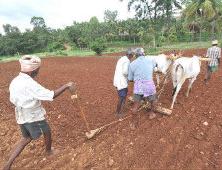
Through initial low investments and guidance drylands can be made productive.
Water as a natural resource has been subject to so much misuse and abuse. As a result today there is an acute shortage of water. Unlike scientific inventions, water cannot be invented. One has to depend on the clouds for it.
Monsoon failures and sudden heavy downpours with flash floods washing away a major portion of the water and fertile top soil into the ocean show how difficult the situation can be, says Dr. G. Nammalvar, organic scientist. In the name of industrialization and urbanization, trees have been cut. With the absence of trees, rains fail and this has a direct impact on the planet. While others may feel it, farmers experience it acutely, and monsoon failure results in a disaster for farmers, especially dry land cultivators.
Moisture retention
For a farmer who depends on rains, conserving every drop of water by increasing moisture retention in the soil is important. Maximizing yield with less water should be his objective. To achieve this one needs to integrate mixture cropping, tree growing and animal breeding. Thus the by-product of one unit will serve as input for another. Labour utilization will be optimum.
Even farmers having fertile land and abundant water resources are finding it hard to practice commercial agriculture. A dryland is not nature-made. Nature is always flourishingly rich. Drylands are man-made. When one goes on cutting trees, over a period of time the area becomes barren and unproductive due to the absence of surface water and ground water recharge. In due course, farmers sell these drylands to traders who buy these lands for a throwaway price and sell it as commercial plots for a huge amount.
Proper planning
By proper planning and initial low investments drylands can be made productive. For example cropping patterns have to be closely monitored. Farmers can grow drought resistant native crops which require less water. Also the native varieties are resistant to pests and infestations. In addition farmers can dig small ponds, or pits in their fields. These serve as effective rain catchers. They can grow fishes such catla, roghu, mirgal and grass carper to get additional food and income when the pits get filled with rain water.
Growing azolla
If they have cattle, azolla can be ideally grown in these water bodies. The azolla can be harvested and used as a feed for their cattle and poultry as it has been proved that azolla increases the milk yield in cattle and egg laying in chicken.The dung from their cattle can be applied time and again over the land. In about 3-5 years they can see for themselves the results, how their lands are turning into productive areas.
If there are trees in the area, farmers can collect the dried fallen leaves from the ground and apply them all over their lands as these leaves serve as effective mulches.They prevent evaporation of moisture from the soil, serve as shelters for earthworms and also act as effective weed suppressers. Not only the leaves, any waste which is available such as kitchen waste, garbage (except polythene or plastic material) can be collected and converted into compost and then vermicompost.
Sustainable livelihood
Integrated multi culture is not only mitigating the impact of climate change it brings about sustainable livelihood for producer and consumer. “But this procedure does not produce an overnight miracle. It takes a minimum of 3-5 years of patience and labour to prepare the land for cultivation under proper guidance.
Contact details: Mr. K. Murali, Indian Organic Agriculturists Movement, e-mail: sadhguru@gmail.com mobile: 94425-31699.
Grow two rice varieties to maximise profits |
|
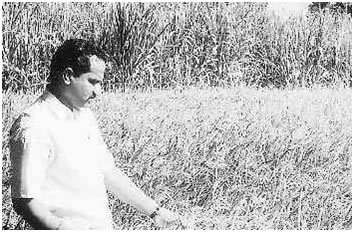
BY GROWING two rice varieties of differing maturity group, according to K. Rajarathinavelu, a progressive rice farmer of Allivaram village, near Pennathur in vellore district, Tamil Nadu he has been able to maximise the farm productivity and profitability.
``It is easier to manage them well, and the labour for harvesting and post harvest handling of the crops with different duration is also well spread out," says Mr. K. Rajarathinavelu..
He was one of the two farmers specially invited to speak at the International conference on "Sustainable Food Security for all by 2020" organised at Bonn, Germany, last September by the International Food Policy Research Institute (IFPRI), Washington D.C. A successful rice grower for well over two decades, Mr. Rajathinvelu has grown ASD-19, a medium-duration (135 days) rice and ASD-13, a short-duration variety (115 days) in 1.2 hectares. "I strictly followed the package of technologies for sustainable rice farming, and used Azospirillum, neem cake along with some complex and straight fertilizers.
I applied liberal quantities of farmyard manure both in the nursery and the main field, and the crop responded well to the three split applications of biofertilizers and top dressing with urea and muriate of potash," he pointed out. The most interesting aspect of the cultivation practices was the spraying with cow's urine and vermiwash three times starting from the 15 th day of transplanting at fortnightly intervals. The crop remained dense green and healthy, and there was no need to resort to any spraying with chemical pesticides or fungicides, according to this enterprising farmer. "About 5 kg of vermicasting was soaked in 10 litres of water and stirred well. The suspension was kept overnight, and the settled liquid was decanted.
This solution and 5 litres of cow's fresh urine was mixed with 85 litres of water, and this fluid was used for spraying the crop," explains Mr. Rajarathinavelu.
The crop was managed well with good irrigation and regular manual weeding. The early variety ASD-13, also called `Super Ponni', gave a higher yield of 3375 kg from 0.6 hectares in 115 days. It produced straw worth Rs. 2500. After another three weeks, the medium-duration rice came to harvest. It yielded about 3225 kg from 0.6 hectares. "Though the yield was very less, it fetched higher price in the market. It also produced more straw (worth Rs. 4000)," says Mr. Rajarathinavelu.
When he harvested the short-duration crop, the market price was lower, and the long-duration crop was right there for him when the price notched up. "The second harvest helped me in getting the good market price," he points out. Again, the arrival of fresh straw was beneficial to the cattle, according to him.
The cost of cultivation for the two crops raised in 1.2 hectares worked out to Rs. 15,000. The gross return from selling paddy was Rs. 45, 730. The straw was used for the farm animals, according to him.
Promising rice variety for semi-dry cultivation |
|
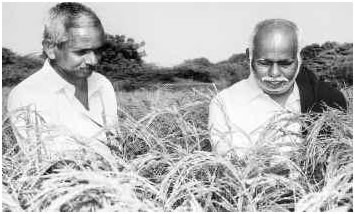
The progressive farmer, Thulasiraman (left) showing the bountiful crop to a visitor.
A PROGRESSIVE farmer in Kancheepuram district of Tamil Nadu has successfully harvested 4.8 tonnes of paddy a hectare from a promising long-duration variety. The variety `J-18', developed by the `J'-Farm, Pudupakkam near Kelambakkam in Kancheepuram district, performed exceedingly well, and yielded good quality grains and lengthy straw with thrifty use of water, according to Mr. S.S. Nagarajan, Senior Vice President (Agricultural Research),
J-Farm.
Pest resistant
The crop grew healthy with the application of neem cake mixed nutrients, and was free from major pests and diseases of rice. Interestingly, the duration of the crop was less by about 35 days than its normal age of 180 days, when it was raised in semi-dry conditions. The cost of weeding was low, and there was no expenditure on plant protection.
Cultivation cost
The cost of cultivation of this variety was far lower compared to the other ruling varieties grown in semi-dry conditions, according to Mr. K.R. Thulasiraman, the progressive farmer of Vallakottai village in Sriperumbudur taluk, who took up `J -18' cultivation under the guidance of Mr. Nagarajan.
The farmer could not take up sowing at the right time (July-August), and was delayed by a month. In spite of it, the variety did well, and grew vigorously in his 0.8-hectare plot. There was no lodging, and the panicles bore well-filled grains.
Late sowing
It is found ideally suited for late sowing, and its reduced duration under semi-dry conditions is another desirable trait. It yielded 4.8 tonnes of grains per hectare, and the long (1.6 m) and stiff straw was sold as roofing material.
The straw from a hectare fetched Rs. 5,000, according to Mr. Thulasiraman. The total cost of cultivation was Rs. 12,500 per hectare, and the crop ensured a net profit of Rs. 30,000 per hectare last season.
Semi-dry cultivation of rice is widely practiced in Kancheepuram, Ramanathapuram, Pudukottai and Kanyakumari districts of Tamil Nadu. It involves direct seeding with traditional bullock-drawn implements such as `guntaka', and covering the seeds immediately. The crop duration extends from July-August to December-January.
Dry crop
The first phase (the vegetative phase) of the crop is raised as a dry crop, and second phase is synchronised to take advantage of the northeast monsoon.
"It is raised with limited water available in the local tanks, and is practiced in tracts with scarce labour, where nursery raising and transplanting will be prohibitively expensive," explains Mr. Nagarajan.
Unwanted vegetation
Weed menace is a major problem in semi-dry cultivation. But this variety, with its vigorous growth habit, has suppressed the unwanted vegetation, and effected a natural weed management.
Its response to organic nutrition, and in-built resistance to pests and diseases also helped in reducing the cost of cultivation. Its early maturity in semi-dry conditions, fine grains and long straw make it an ideal substitute to the existing varieties grown as semi-dry crop.
Low cost rice for semi-dry cultivation |
|
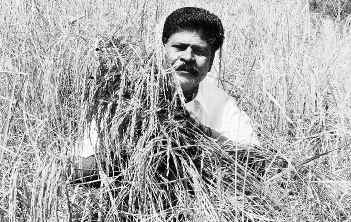
PROGRESSIVE FARMER: Ramachandra Naidu had sown the seeds during the
Khariff season (June-August).
A LONG duration rice variety J-18, has been developed at `J' farms Pudhupakkam, Kanchipuram district, Tamil Nadu. It has excellent grain and straw quality and is ideally suited for organic farming, according to Mr. S. S. Nagarajan, Senior Vice President, `J' farms.
The crop variety is ideal for growing along the coastal belt of Tamil Nadu, according to Mr. Nagarajan.
"The grain quality of J-18 improves when the crop is raised using organic methods of cultivation.
"The straw from organically grown J-18 is relished by cattle," he said.
J-18 variety was developed from the Wag-wag rice variety from the Philippines, according to Mr. Nagarajan.
Semi-dry cultivation
"This variety is found to grow well in semi-dry conditions, where abundant water supply is unavailable for growing other rice varieties," he said. "The crop has a thick and robust stem and does not lodge in the field like other rice varieties," explained Mr. Nagarajan.
Non-lodging variety
"This non-lodging in the field is an important trait of this variety, since it can be easily harvested mechanically in places with labour shortage," he said. The variety is endowed with more grains per panicle, and there is practically no chaffness (husk), according to him.
Mr. C. Ramachandra Naidu of Aalathur village in Kanchipuram district is a progressive farmer who has raised this variety in his 30 acres of land under semi dry conditions.
The crop comes to harvest in about 135 days after sowing under semi-dry cultivation, according to Mr. Nagarajan.
With technical guidance from J-farm, he had sown the seeds during the Khariff season (June-August) in his 30-acres land.
" Unlike other rice varieties, which have to be sown in the nursery and then transplanted to the main field, I directly sowed the seeds in the main field after ploughing my land. "I had also not carried out any weeding operations or applied manure or chemical fertilizers for the crops," he said. "The crop is robust by nature and is quite resistant to major pests and diseases.
"The variety responds well to organic manures and there is no need for applying any chemical fertilizers," said Mr. Nagarajan.
Though heavy rains during the monsoon had washed away a portion of the crop cultivated in Mr. Ramachandra's field, the remaining crop in about 15 acres had not been damaged by the floodwaters, according to Mr. Nagarajan.
Flood resistant
"Though the crop was completely submerged for more than a week, as soon the water started draining the panicles did not exhibit any damage," said Mr. Ramachandra.
Mr. Nagarajan said, "organically grown J-18 rice fetches a premium price in the market. A 75 kg bag of J-18 at present is being sold for a sum of Rs.500 in the local market.
According to Mr. Ramachandra, there is no grain discolouration and the rice recovery is high with virtually no breaking of grain tips.
Mr. Ramachandra has invested a sum of about Rs. 21,000 for growing this variety.
He is expecting a net return of about rupees one lakh from his 15 acres (about 200 bags in about five months). The straw harvested from an acre can be sold for about rupees five thousand, according to Nagarajan.
Contact details: Mr. C. Ramachandra Naidu, Yadava street, Alathur village, via Tiruporur, Kanchipuram district, phone: 9380-141721 and Mr. S.S. Nagarajan, J-Farms, Pudhupakkam post, via kelambakkam, Kanchipuram district-603103, Phone:04427474348.
Savouring sweet success with sugarcane cultivation |
|
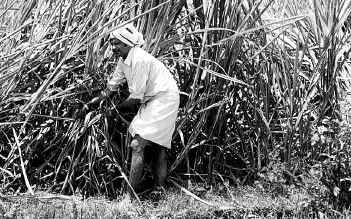
MOTIVATOR: R. Kannan has motivated other farmers in his village who had faced losses
in their paddy crops to take up sugarcane cultivation.
SUGARCANE CULTIVATION can be a profitable enterprise for farmers of Tamil Nadu.
The main reason for a number of farmers entering sugarcane cultivation is that the cost and water requirement for cultivating sugarcane is less compared to paddy crops.
Stable price
Sugarcane farmers get an assured price for their harvest, unlike other crops, which have a fluctuating price and lack of marketing feasibility.
Mr. R. Kannan, a progressive sugarcane farmer of Kaveripakkam Village, Vellore District, Tamil Nadu has been successfully growing sugarcane in his two-hectare farm for the past 10 years.
He has motivated other farmers in his village who had faced losses in their paddy crops to take up sugarcane cultivation.
Good sugar recovery
He is at present growing the CO-86032 variety in his farm. This variety can be harvested four times in three years (1+3 ratoons) and has a good sugar recovery rate of 10-11.5 per cent. "About nine tonnes of sugarcane buds (planting material) are required for planting in a hectare," he said.
Before planting, the buds were immersed in a solution of 5 kg of urea and 250 gms of carbendazim diluted in 250 lt. of water to prevent any infestations, according to him.
About 12 tonnes of farmyard manure and 350 kg of super phosphate were applied to the fields and ploughed into furrows.
Planting technique
The buds were planted on the sides of the furrows and the field beds irrigated, according to Mr. Kannan. "After the fifth day of planting about 2.5 kg of Atrazine weedicide diluted in about 200 lt. of water was sprayed in the field to control weed growth," he said.
Spraying weedicide should be preferably done in the early mornings, he explained.
The buds germinate in 15-30 days. Forty days after planting a fertilizer dose comprising 250 kg of DAP (Di-ammonium-phosphate), 100kg of urea and 12 kg of sevidol was applied to the crops as a side dressing, according to Mr. Kannan.
"Immediately after fertilizer application the soil around the base of the clumps was packed tightly," he said.
A second application of 250 kg each of complex, urea, potash and neem cake was made 90 days after planting.
The crop has to be irrigated at frequent intervals to obtain more yield, according to him. "During the summer, irrigation was done once in ten days," he said.
Pest attacks
Detailing on pest attacks on his crops he said, "woolly aphid infestation was prevalent in my crops especially during the monsoon. "Spraying a solution of 600 gm. of acephate diluted in 80 lt. of water once over the sugarcane clumps was found effective."
A third application of about 375 kg of urea alone was made as a side dressing to the crops on the seventh month after planting, according to him. "In about eight months after planting I had harvested my first sugarcane clumps and sold them at Rs.1,075 per tonne to farmers as seed buds," he said.
"The second ratoon harvest was done in 10-12 months and subsequent ratoons were harvested in the same time interval," he said.
Yield data
"I got an average yield of about 150 tonnes of sugarcane," he said.
Mr. Kannan had spent Rs. 1,10,000 for cultivating the crop. His gross income by selling his produce to the sugar mill at the rate of 1,075 per tonne was about Rs.1,80,000.
His net profit after deducting the expenses was about Rs. 75,000.
Contact Details: Mr. R. Kannan can be contacted at No. 67, Bazaar Street, Kaveripakkam, Vellore district, Tamil Nadu, mobile: 94434-48885.
Growing paddy for seeds is a better option for ryots |
|
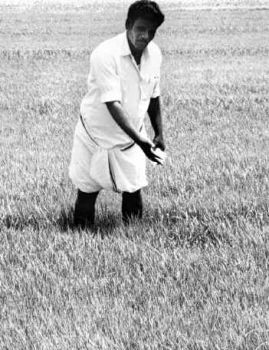
IDEAL VARIETY: Desamuthu has been growing the paddy variety for the past ten years.
Paddy Cultivation has been the main occupation for a number of farmers in South India. Though the returns from paddy depend largely on the weather conditions and the market price, a majority of ryots continue to cultivate the crop with a handful of them drifting away from the regular paddy crop to other varieties.
Mr. M. Desamuthu, a progressive farmer of Keelambi village in Kanchipuram district, Tamil Nadu, has been cultivating paddy seeds for the past 10 years. Unlike other farmers in his area, Desamuthu is not content with growing paddy and selling it in the local market. He has entered into a contract to sell the seeds to the agricultural office in his area.
Seed-to seed technology
Commonly known as seed-to-seed technology the agricultural office supplies the seeds to the farmers and buys back the harvested produce directly from them.
According to Mr. C. Perumal, retired assistant agricultural officer, Kanchipuram, cultivating paddy seeds is a better option for ryots, because farmers get Rs.2 per kilo more than the market price by selling the seeds to the agricultural department.
Desamuthu, has been growing a hybrid rice variety, called Ponni in Tamil, in his eight hectare field. He had got the seeds for cultivation from the Department of Agriculture, Sirucauverypakkam, Kanchipuram. The seeds were first sown by broadcasting method on raised nursery beds prepared by mixing about 2 tonnes of farm yard manure and about 40 kgs of DAP (di-ammonium-phosphate) and irrigated, explained Mr. Desamuthu. On the 10th day about 5 kg of furadon was sprinkled over the beds to prevent stem borer infestations.
Transplanted seedlings
The seedlings were plucked on the 30th day after sowing and transplanted in the main field. Before transplanting, about 25 tonnes of farmyard manure, 50kg of urea and 20kg of potash and phosphorus each are applied to the main field and ploughed well. The seedlings were planted at 6 x 4 cms on raised beds and irrigated, according to Desamuthu. Weeding has to be done on the 25th and 45th day and two side dressings of about 75 kg of urea, 50 kg of potash and 2 kg of neem cake must be applied on the above-mentioned days.
Grain formation
On the 60th day about 70-75 kgs of ammonium chloride or potash must be sprinkled over the crop, which helps in good grain formation. The crop comes to harvest in about 125 days after planting and from one hectare about 10 tonnes of paddy can be harvested. Growing paddy seeds is feasible for farmers who have about 5 hectares of land, according to Mr. Perumal. "Interested ryots can contact the local agricultural office in their area.
"Officials make a field visit to study the feasibility of the soil type, irrigation facilities and suitable variety that can be grown," said Mr. Perumal. A contract is then signed, which states that the farmer should sell his produce directly to the office, he explained.
Payment details
Farmers are paid a part of the money immediately after their harvest. The grains are subjected to lab tests to make sure that they adhere to quality standards and the final amount is paid later. Mr. Desamuthu had spent about Rs.2,40,000 for cultivating paddy seeds in his eight hectares. His gross income after selling his produce is about Rs.3,60,000. His net income after deducting the expenses is about Rs.1,20, 000.
Contact Details: Mr. M. Desamuthu, Keelambi village, Krishnapuram post, Kanchipuram district, Tamil Nadu, mobile: 93804-37744 and Mr. C.Perumal can be reached through mobile at 99940-91891.
Reducing cultivation price, with a fern that's nice to rice

BASAL APPLICATION: Paddy farmer Mr. S. Ramuvel in Mayiladuthurai taluka in Tamil Nadu is growing azolla in his field.
Modern Agriculture has become more dependent on chemical fertilizers for increasing yield of crops. Constant use of chemicals has spoilt the land, soil and water.
Depletion of soil fertility and high prices of chemical fertilizers have forced many paddy farmers, especially in the delta region, to turn towards azolla as an effective bio fertilizer for their paddy crops.
Nitrogenous fertilizer
Basal application on green azolla manure at the rate of 10-20 tonnes per hectare increases soil nitrogen by 45-60 kg and reduces 20-30 kg of nitrogenous fertilizer requirement of rice crop, according to researchers from Tamil Nadu Agricultural University (TNAU), Coimbatore, Tamil Nadu.
Farmers should be made aware of the harmful effects of these chemicals in agriculture and switch over to non chemical methods of growing crops, according to Mr. S. Ramuvel, an organic paddy farmer in Mayiladuthurai taluka, Nagapattinam District of Tamil Nadu.
Azolla can be used as a good substitute for urea for paddy crops and can also be used as a feed for cattle, ducks, pigs and fish because of its high protein content.
It can also be converted to compost by drying under shade and then used like farmyard manure.
Also called mosquito fern and water velvet, azolla is a naturally available free-floating aquatic fern mostly found in moist soil, ditches, and pools.
Though the fern is widely cultivated in some Asian countries such as Japan, China, Vietnam, and the Philippines, in India it is yet to gain more prominence except in some states such as Kerala and Orissa.
It is eco friendly, non expensive and helps in safeguarding the soil health and also the quality of crop products.
The fern fixes atmospheric nitrogen into the soil to be made available to crops especially wetland rice crops in the form of soluble nitrogen.
A thick green mat of azolla in the paddy field prevents weed growth and helps paddy growth. It also prevents water evaporation and increases water use efficiency in the crops.
Lower cost
"When I was cultivating paddy with chemical fertilizers I had to spend about Rs.1,500 per acre.
At present, with azolla, the cost of cultivation has come down by 25 per cent. Azolla has increased my paddy yield by 30-40 per cent," said Mr. Ramuvel.
Farmers can also create their own nursery for growing this fern, according to Mr. Ramuvel. The field should be ploughed, levelled, irrigated, and made to stand in the form of small ponds.
Only 15-20 cm of standing water is allowed in the fields. Green azolla at the rate of 20 kg per hectare, mixed with fresh cow dung should be released into the pond.
Dense green mat
The fern multiplies rapidly in about 10-15 days and forms a dense growth on the surface of the water. It is then harvested using bamboo baskets and released into the main field among the transplanted paddy crops for further multiplication.
Mr. Ramuvel is also selling the green azolla at the rate of Rs. 5 per kg to other farmers who do not have a nursery.
During summer azolla is harvested at an interval of 15-20 days and during monsoon, once a month.
Contact details : Mr. S. Ramuvel at Muruga Mangalam, Thirumangalam post, Mayiladuthurai taluka, Nagapattinam District, Tamil Nadu, phone: 04364-230774, mobile: 94420-67211.
|
|










